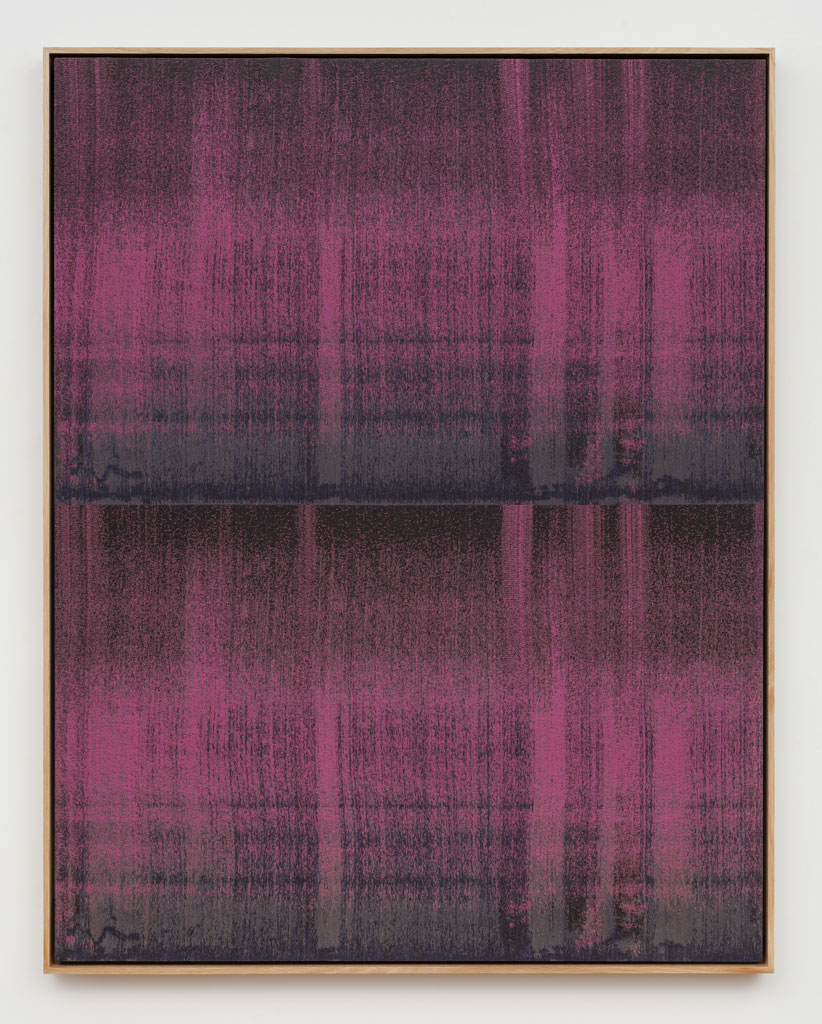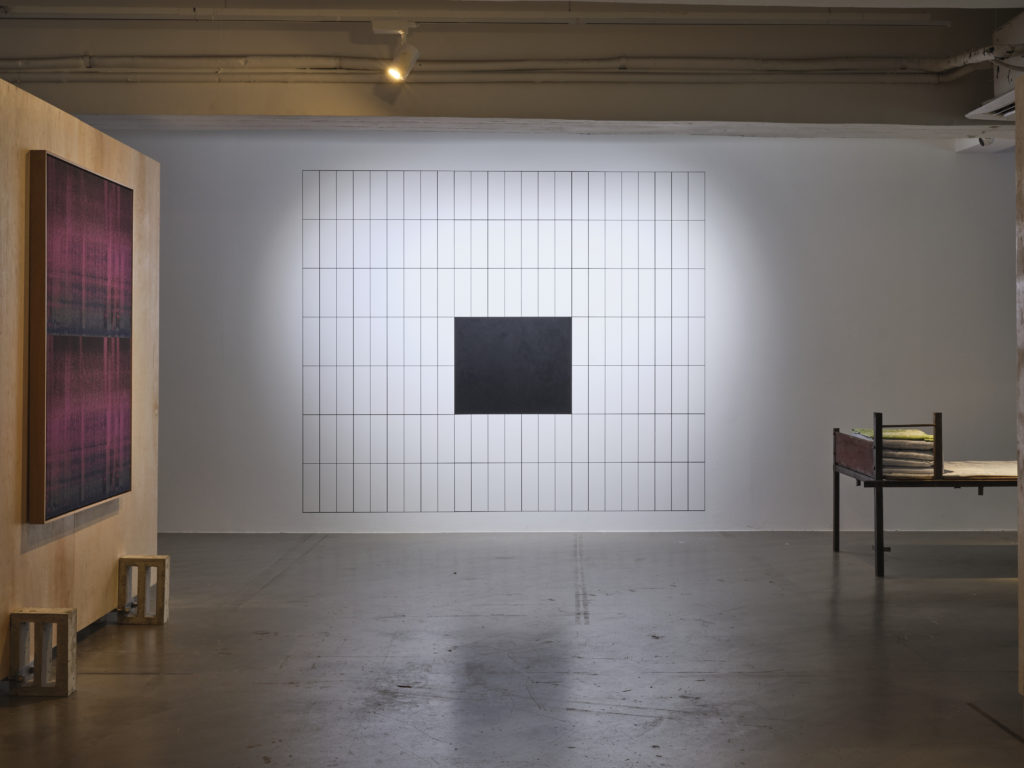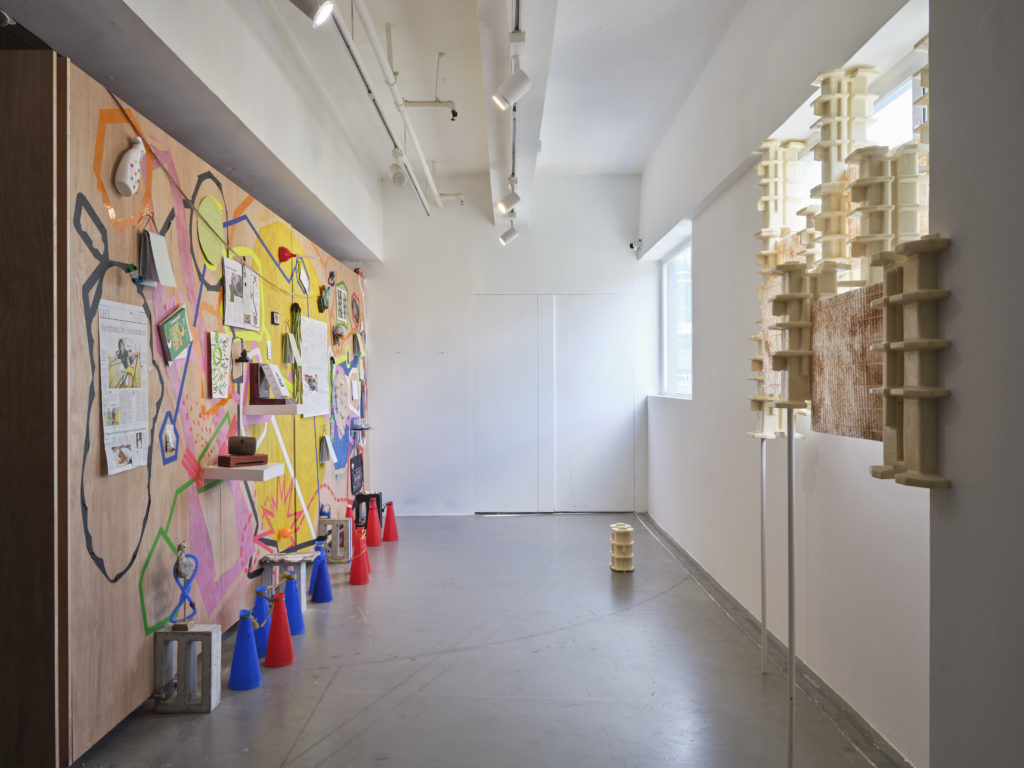By Amandine Vabre Chau
Proposée par Celia Ho et Billy Tang, le nouveau directeur de Para Site, l’exposition signals…瞬息 s’étend sur six mois et se déroule en trois phases. D’abord storms and patterns (tempêtes et motifs), puis folds and splits (plis et fissures) et enfin here and there (ici et là).
Inaugurée en mars, cette exposition est axée sur le temps et son passage. Elle adopte une méthode curatoriale mouvante grâce à une configuration ambitieuse de l’espace et à une sélection d’artistes minutieuse. Avec certain.e.s participant.e.s restant pour les trois parties et d’autres qui se succèdent, Para Site nous propose un mélange dynamique de formats et d’approches variés qui s’entrechoquent dans une exposition méticuleusement arrangée. La deuxième partie s’est achevée le 30 juillet et le troisième et dernier chapitre a débuté le 12 août. L’exposition signals sera visible jusqu’au 29 septembre. Bien que tardive, nous espérons que cette présentation permettra de faire connaître les passionnants projets de Para Site à un nouveau public.
Curated by Celia Ho and Para Site’s new director Billy Tang, ‘signals…瞬息’ is a six months long exhibition unfolding in three parts. First ‘storms and patterns‘, then ‘folds and splits‘, ending with ‘here and there‘.
Opened in March, this time-based exhibition embraces its moving curatorial method through an ambitious configuration of its space and a careful selection of artists. With some participants staying for all three parts and others coming and going, Para Site presents a dynamic blend of various formats and approaches bouncing off each other in a meticulously arranged show. As the second part came to an end on the 30th of July, they began the third and final chapter on the 12th of this month. ‘signals’ will be on view until September 29th. Although belated, we hope this review can introduce Para Site’s engaging projects to a new audience.

「瞬息⋯⋯展與接」展覽現場,香港Para Site藝術空間,2023年。攝影:何兆南。
La première itération de signals s’est concentrée sur l’organisation de l’espace. Sa structuration, mais surtout sa rareté, ce qui fait écho aux préoccupations liées aux logements subdivisés où les personnes vivent en rangs serrés. L’exposition folds and splits, que j’ai eu le plaisir de voir, s’est penchée sur les temporalités transitoires, intermédiaires et ambivalentes. Refusant une conception linéaire de l’espace-temps, l’exposition explore les passages, les carrefours et l’entre-deux de ses différents états. À l’aide de multiples panneaux de bois mobiles conçus par Joel Austin, Celia Ho et Billy Tang ont divisé la galerie en fonction de leurs besoins curatoriaux. Inspirés par les briques emblématiques de Hong Kong que l’on trouve dans les habitations publiques, les blocs qui soutiennent ces panneaux ont permis de créer une structure facilement transportable et mobile. Selon les besoins, une zone fermée, ouverte ou en forme de tunnel pouvait prendre forme. Parallèlement à chaque phase unique du programme, cette méthode a permis de créer des chemins scellés ou connectés, reflétant ainsi l’exploration itinérante du projet. En utilisant peu de matériaux, cette démarche répondait également au besoin croissant de maintenir une approche durable dans la conception des expositions. Cette question a été abordée par la galerie le 29 juillet lors d’une conférence sur les processus écologiques dans le monde de l’art.
The first iteration of ‘signals’ focused on the organising of space. Its structuring but most specifically its scarcity, echoing the concerns of subdivided housing. ‘Folds and Splits’, which I had the pleasure of seeing, delved into transitional, intermediate and ambivalent temporalities. Refusing a linear conception of space and time, the show explored passageways, crossroads and the in-betweenness of various states. Using multiple movable wood-boards designed by Joel Austin, Celia Ho and Billy Tang divided the gallery according to their curatorial needs. Inspired by Hong Kong’s iconic bricks found in public housing estates, the blocks upholding these panels allowed an easily transportable and movable structure to form. Depending on one’s requirements, an either closed-off, opened, or tunnelling area could shape itself. Paralleling the show’s each and every unique phase, this method resulted in sealed or connecting paths, a reflection of the ongoing exploration of the show. Using little material to produce, this also addressed the rising need to maintain a sustainable approach to exhibition designs which was addressed by the gallery on the 29th of July with a talk on eco-friendly processes in the art world.

「瞬息⋯⋯展與接」展覽現場,香港Para Site藝術空間,2023年。攝影:何兆南。
( With multimedia sculpture ‘Tree of Life’ by Linda Chiu-Han Lai on view.)
Imaginant le temps comme une série de plis et de fissures, Para Site nous présente une exploration des notions de contradictions, répétitions, renouvellements et transformations dans un contexte spacial et temporel symbolisé dans différentes œuvres d’art.
En entrant dans la galerie, nous sommes d’abord accueillis par la sculpture multimédia Tree of Life de Linda Chiu-Han Lai, composée d’une accumulation de nombreux objets tels que du bambou, des gadgets électroniques, des pliages de papier, des tissus et bien d’autres encore. Cette œuvre mêle récits personnels, expérimentaux et politiques : il s’agit d’un assemblage d’éléments anti-consuméristes, biographiques, et oubliés de la vie quotidienne. L’œuvre de Linda Chiu-Han Lai se développe progressivement au fil de l’exposition, de nouveaux composants étant ajoutés à chaque phase. De nouveaux « fruits » apparaissent alors pour que nous les découvrions. Tree of Life représente bien l’objectif de cette exposition qu’est de présenter des œuvres d’art malléables qui fluctuent dans le temps, qui se développent au fur et à mesure de l’exposition, et parallèlement à celle-ci.
Imagining time as a series of folds and splits, Para Site introduces us to an exploration of contradictions, repetitions, renewals and transformations linked to space and time in different artworks.
When entering the gallery, we are greeted by Linda Chiu-Han Lai’s multimedia sculpture ‘Tree of Life’, composed of an accumulation of many items including bamboo, electronic gadgets, paper foldings, fabrics and more. This piece collides personal, experimental and political narratives together: it is a combination of anti-consumerist, biographical and forgotten elements of everyday life. Linda Chiu-Han Lai’s piece grows progressively as the exhibition continues, new components being added in each phase with new “fruits” appearing for us to discover. ‘Tree of Life’ embodies this exhibition’s aim to showcase malleable artworks that fluctuate in time, in space and meaning, developing as the show does, alongside it and parallel to it.

「瞬息⋯⋯展與接」展覽現場,香港Para Site藝術空間,2023年。攝影:何兆南。
(With sculpture ‘The past from the ruins’ by Jaffa Lam on view.)
À côté se trouvait l’œuvre spécialement commandée pour l’occasion à Jaffa Lam, The past from the ruins. Particulièrement intéressée par cette œuvre, j’ai été agréablement surprise d’entendre Celia Ho expliquer l’intention de l’artiste derrière ce ballon de football à toute apparence ordinaire. Évoquant le sentiment d’isolement et de solitude lié à la migration et au déplacement, cet objet est déplacé dans l’espace pendant toute la durée de l’exposition. Semblable à un migrant à la recherche d’un refuge, cette pièce doit être placée à côté d’une autre œuvre existante. En quête d’un abri, elle marque chacun de ses arrêts par une photo polaroid placée à l’endroit où elle est restée, nous permettant de retracer chacun de ses pas à travers ses yeux. Pesant 15 kg, sa lourdeur reflète le sentiment d’être figé dans le temps, bloqué voire immobilisé, ce qui rend le mouvement ardu et difficile. Pourtant, le choix de Jaffa Lam rappelle les joies adolescentes d’un sport élémentaire, un divertissement accessible à tous. C’est cependant son sous-entendu conceptuel qui m’a le plus interpellée : c’est une oeuvre d’art qui n’existe qu’en relation avec d’autres oeuvres. Elle nécessite qu’une autre pièce, déjà existante, soit placée à proximité. Elle cherche à survivre dans l’autre et ne peut survivre qu’avec l’autre. Comme un enfant s’accrochant à un rameau d’olivier, cette œuvre d’art exige plus qu’elle-même, plus que sa propre existance, elle demande une autre présence. La contribution de Jaffa Lam montre le soin apporté à la conception de signals…瞬息, elle invite le public à pénétrer dans l’espace comme elle le fait et nous encourage à suivre les liens entre les différentes pièces. Elle nous demande d’être au centre de ce carrefour de propositions et d’observer attentivement. Les artistes choisis nous appellent, nous interpellent et nous rappellent, les uns et les autres, les uns aux autres, en faisant écho à chacun.e et aux idées inscrites dans la conception curatoriale de cette exposition.
Next to it was Jaffa Lam’s newly commissioned work ‘The past from the ruins’. Particularly interested in this piece, I was pleasantly surprised to hear Celia Ho explain the artist’s intention behind the seemingly ordinary football. Evoking the feeling of isolation and loneliness derived from migration and displacement, this object is moved around the space throughout the duration of the show. Akin to a migrant seeking refuge, this piece is to be placed next to another existing work. Pursuing shelter, it marks its every stop through a polaroid photo positioned where it stayed, making us able to trace its every step through its eyes. Weighting 15kg, its heaviness mirrors the sense of being stuck in time, frozen, making movement arduous and difficult. Yet, Jaffa Lam’s choice of design recalls the adolescent joys found in an elementary sport, an accessible entertainment found in all walks of life. Its conception is what especially called out to me: it only exists in-relation-to. It requires another already existing piece to be placed nearby. It strives for survival in others. Akin to a child holding on to an olive branch, this artwork demands more than itself. Jaffa Lam’s contribution demonstrates that care was put into the conception of ‘signals…瞬息’ as it invites the audience in, encourages us to follow the links between different pieces. It asks us to be at the center of this crossroad of propositions and observe carefully. The chosen artists are calling to, calling towards and calling back to us; to each other, and to larger ideas inscribed in this exhibition’s curatorial conception.

Cotton, polyester, rayon, wool acoustic baffling felt, and white oak – 139.6 x 110.3 x 5.7 cm (framed)
© Mika Tajima, Courtesy of the artist. Photo: Charles Benton

「瞬息⋯⋯展與接」展覽現場,香港Para Site藝術空間,2023年。攝影:何兆南。
(With Mika Tajima’s Negative Entropy on view, on the left.)
« Signals » (Signaux) s’avère être la description parfaite en voyant le travail de Mika Tajima qui est plein de signes internes, d’indications et d’appels. Negative Entropy est un portrait abstrait tissé au Jacquard. L’artiste enregistre des sons dans des lieux et environnements spécifiques, puis les retranscrit en images abstraites lyriques révélant l’invisible, un paysage sonore. Son travail est à la fois un enregistrement, une traduction, un rappel et une interprétation. Cette pièce s’inspire du fait que le code binaire (0 et 1) que nous utilisons pour coder les données serait un emprunt à la machine à tisser Jacquard, qui utilise une série de cartes perforées pour automatiser le processus de tissage des motifs. Semblable à un pont entre deux mondes, cette peinture nous permet de mettre en évidence les liens et les relations entre des domaines apparemment disparates grâce à leur matériau commun : le codage. L’œuvre de Mika Tajima plonge au cœur des problématiques liées aux interventions humaines. Elle explore le point de contact entre contrôle, automatisation, progrès technologique, données et les émotions humaines.
“Signals” turns out to be the perfect descriptive as Mika Tajima’s work is full of internal signs, indications and callings. ‘Negative Entropy’ is an abstract Jacquard woven portrait. The artist records sound patterns in specific locations and environments, then transcribes them into lyrical abstract images revealing the invisible, a landscape made of sound. Her work is simultaneously a recording, a translation, a call-back-to and an interpretation. This piece takes from the fact that the binary code (0s and 1s) we use to encode data, is believed to borrow from the Jacquard loom machine, which utilises a series of punched cards to automate the process of pattern weaving. Similar to a bridge between two worlds, this painting allows us to point to the connections and relationships amidst seemingly disparate domains through their common material: coding. Mika Tajima’s work delves deep into human agency, the contact point between control, automation, technological progress, data and human emotions.

「瞬息⋯⋯展與接」展覽現場,香港Para Site藝術空間,2023年。攝影:何兆南。
L’exposition signals…瞬息 : folds and splits présente une sélection pertinente d’artistes, tant établi.e.s qu’émergent.e.s, avec des approches variées mais significatives. Iels sont tous.tes rattaché.e.s aux questionnements de l’exposition sur la temporalité, la connexion, l’espace et la transformation. Chaque phase de ce projet nous montre une autre facette de ses recherches à travers l’ajout de nouveaux artistes, la reconfiguration de l’espace et la modification des œuvres. Il s’agit d’une proposition mûrement réfléchie qui nous invite à examiner attentivement la corrélation entre chaque création, entre l’espace et le temps, ainsi qu’entre l’individuel et le collectif. Ou plus précisément, d’observer les signaux émanant de, vers et à travers chaque pièce ainsi que leur rapport avec nous, le public.
‘signals…瞬息: folds and splits’ has a pertinent selection of artists, both stablished and emergent, with varied yet meaningful approaches. They all relate to the exhibition’s inquiry into temporality, connection, space, structure and transformation. Each phase of this project shows us another facet of its questioning through newly added artists, the reconfiguration of its space and modified artworks. We are presented with a thoroughly thought-out proposition inviting us to look carefully, and with care, to the correlation between each artwork, between space and time, and the individual and the collective. Or more so, to observe the signals emanating from, to and through each piece and its bouncing back and forth with themselves and us, the audience.

「瞬息⋯⋯展與接」展覽現場,香港Para Site藝術空間,2023年。攝影:何兆南。
ACA project est une association française dédiée à la promotion de la connaissance de l’art contemporain asiatique, en particulier l’art contemporain chinois, coréen, japonais et d’Asie du sud-est. Grâce à notre réseau de bénévoles et de partenaires, nous publions régulièrement une newsletter, des actualités, des interviews, une base de données, et organisons des événements principalement en ligne et à Paris. Si vous aimez nos articles et nos actions, n’hésitez pas à nous soutenir par un don ou à nous écrire.
ACA project is a French association dedicated to the promotion of the knowledge about Asian contemporary art, in particular Chinese, Korea, Japanese and South-East Asian art. Thanks to our network of volunteers and partners, we publish a bimonthly newsletter, as well as news, interviews and database, and we organise or take part in events mostly online or in Paris, France. If you like our articles and our actions, feel free to support us by making a donation or writing to us.
